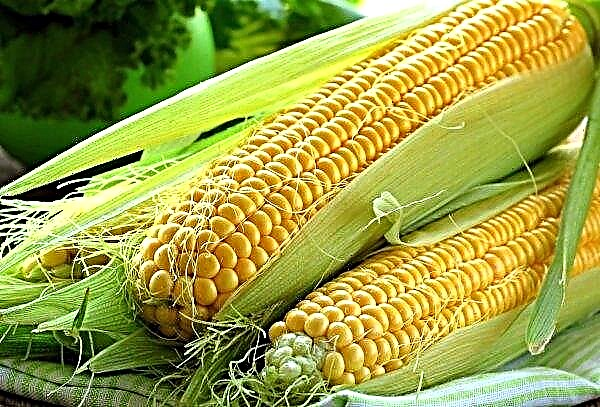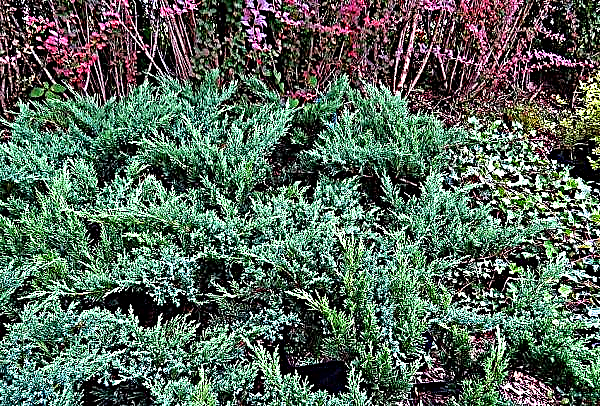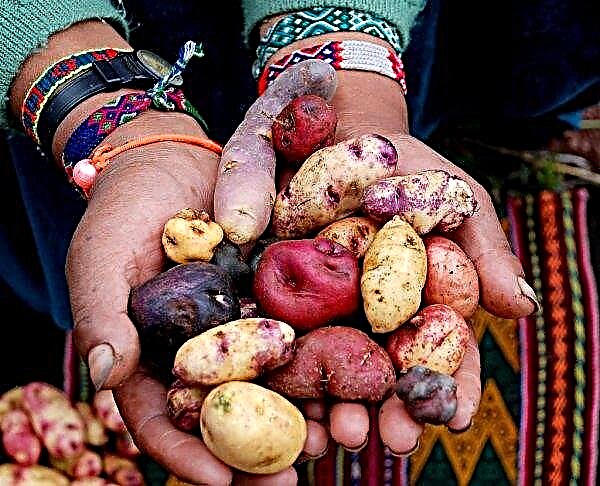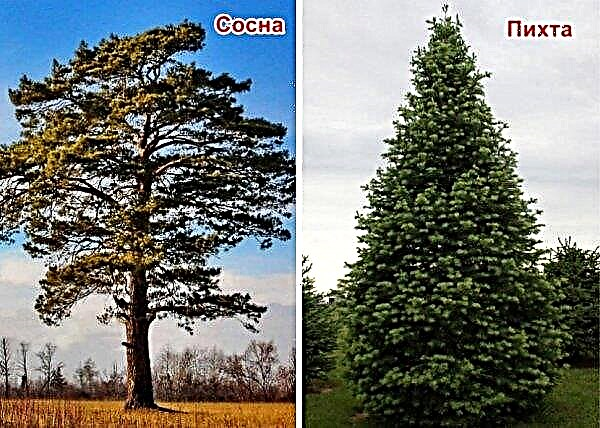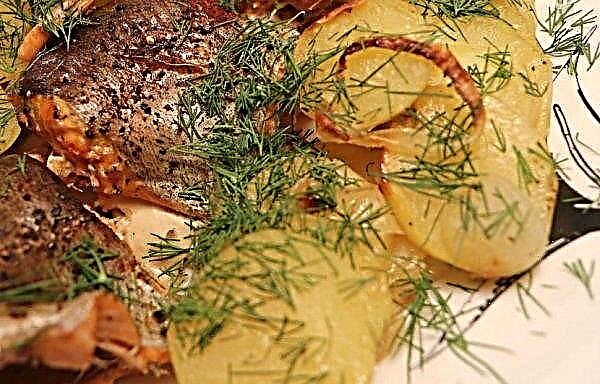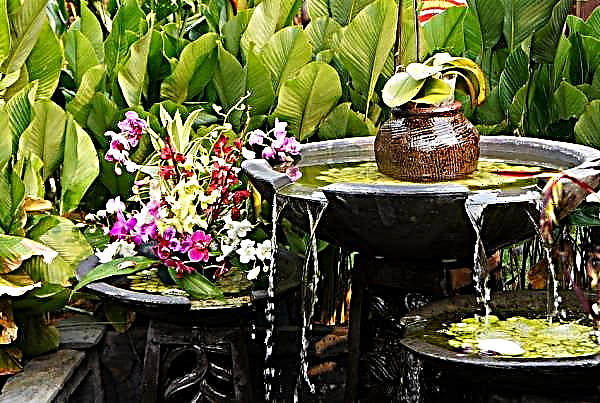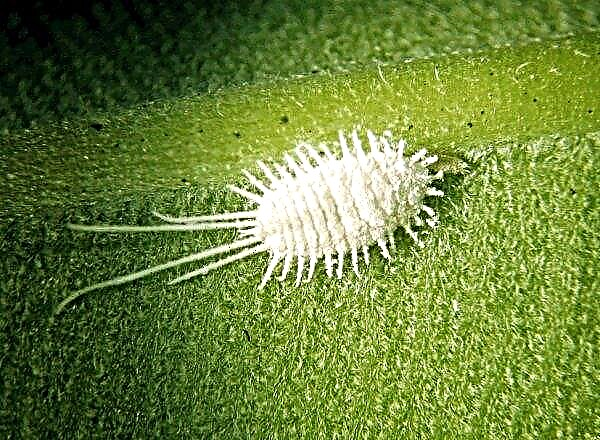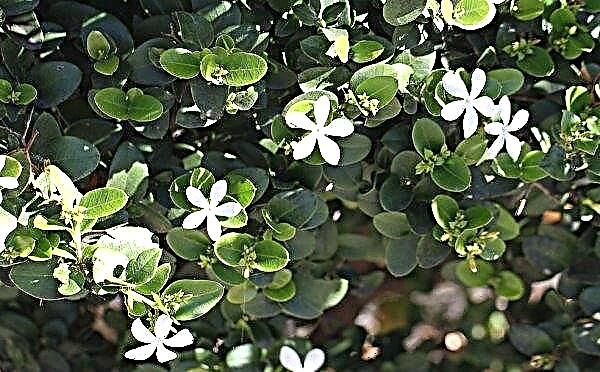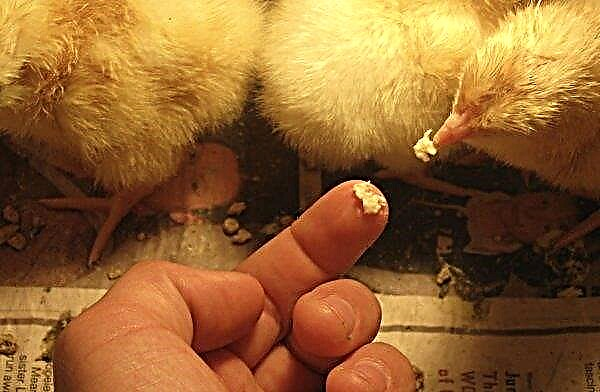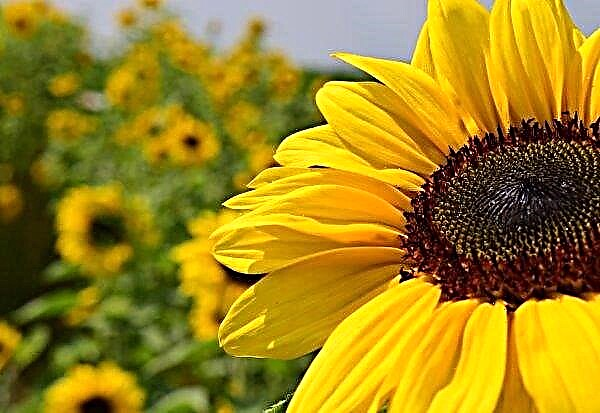There are a lot of diseases of potato, they can have a fungal, viral and bacterial nature of origin, therefore, we will consider the most common diseases from these three groups, the reasons for their appearance and treatment features in case of damage to the bushes.
Fungal Potato Disease
Fungal diseases of potato are considered the most dangerous and difficult to cure. The fungus appears on the bushes due to improper cultivation conditions or is carried by insects.
Scab
Scab - the most common disease of a fungal nature, numbering many varieties, the symptoms of which are manifested in different ways.

Although the nature of the lesion varies depending on the variety, the preventive measures will be the same. It is impossible to cure already diseased potatoes so that the signs of defeat disappear, therefore, it is better to prevent the development of the fungus, taking into account the following general tips:
- First of all, it is important to pay attention to crop rotation, the frequency and quality of the applied fertilizing. To provoke the spread of fungal infection in the garden, you can use fresh straw manure, compost, or by introducing an excessive amount of nitrogen-containing fertilizing.
- For prevention, it is recommended to fertilize the territory with manganese and ammonium sulfate in the amount of 60 kg of fertilizing per 1 ha of area.
- Before planting, tubers should be treated with Prestige or Maxim.
- Do not plant diseased or damaged planting material.
- During the flowering period, bushes should be watered with 0.5 l of water daily.
- Regularly spray bushes with Fitosporin, according to the instructions.
Common
Common scab affects the fruits of potatoes - the fungus penetrates through the eyes. There are 4 types of manifestations of the disease - flat, netted, convex and deep. The first type of lesion is characterized by the appearance of an uneven brown crust on the surface of the tubers.
With a mesh lesion, asymmetrical cracks develop on the fruits. Dark growths on the fruits are a sign of a convex type of ordinary scab. Deep scab on potatoes is manifested in the form of depressed ulcers, 0.5 cm in depth, accompanied by torn parts of the peel.
 Flat, mesh, convex and deep
Flat, mesh, convex and deep
The reason for the appearance of ordinary scab on potatoes is the vital activity of a radiant fungus from the genus Streptomycetes. The development of the fungus is provoked by improper cultivation agrotechnics. Most often, common scab develops on potatoes growing on limestone, sandy and sandy loamy soils.
Hot, dry summers create ideal conditions for the development of the disease. Drugs for the treatment of common scab are not produced, therefore, to protect the crop, resort to general preventive measures.
Black
Black scab appears at any stage of tuber development, in addition, it can affect not only the fruits, but also the terrestrial part of the plants. The bush looks weak during the lesion period - a small number of small leaves cover thin stems. Over time, brown ulcers appear on the stems, in the basal part you can notice a white coating - mycelium.

The tubers are covered with black wart spots. The main reason for the development of black scab is excessive humidity and cool weather. Planting tubers sprouted in the dark in unheated soil can also cause fungus to appear.
Since the disease affects the entire bush in order to preserve the crop, it is necessary to resort to the treatment of plants with “Ditan M-45”, “Kolfugoy”, “Mancozeb”, according to the instructions and carry out general prevention of scab.
Important! To preserve the harvest, they recommend harvesting potatoes earlier than usual, so that the wet and cold autumn weather does not provoke the development of the disease.
Powdery
Powdered scab can cause the death of the plant, since the fungus affects not only the tubers, but also the root system, which entails the withering and drying of the stems. The disease manifests itself with white plaque on the roots and brown shallow ulcers on the fruits.

Over time, the ulcers burst, forming a relief surface, which over time is completely filled with spores of the fungus. At the last stage of potato damage, the process of decay of the fruits begins. Wet cool weather can provoke activation of spores of the fungus.
Most often, the disease manifests itself in soils with a heavy composition. Contaminated manure can become a source of spores (spores do not die, even when passing through the animal’s digestive system). To protect the crop, general scab prophylaxis is needed.
Silver
The disease is provoked by a specific type of fungus that affects only the surface of the potato peel. The disease begins to appear when the mycelium is already well developed, at which time the peel is covered with dark brown heels.

A heavily affected crop has dents with a silver coating on the spot previously located spots. Improper agricultural technology, increased soil moisture and heat can provoke the development of the disease. To preserve the crop, attention should be paid to general preventive measures.
Alternariosis (dry spotting)
The development of the disease is most often observed in the hot dry summer period, the young shoots of the plant take the first blow. The defeat of the fruits occurs only in the advanced form of the development of the disease. Varieties of medium and late ripening are more susceptible to infection.

The main cause of potato alternariosis is considered to be the untimely application of mineral fertilizers that “create” immunity to this disease. Soils poor in potassium and phosphorus are a potential source of parasitization of a dangerous fungus.
The first signs of alternariosis are the appearance of brown spots on the leaves. Fungal spores usually live in the upper layers of the soil, therefore, they can infect the fruits only when harvesting, with direct contact. After infection, the fruits after 2-3 weeks are covered with dark spots.
When you notice the first signs of alternariosis on the leaves for medicinal purposes, you must:
- treat the bush with a 1% solution of Bordeaux fluid (4 times a day, for a week);
- use the drug "Arceride" with severe damage to the bushes, according to the instructions.
Verticillosis
A fungal disease that activates in the hot summer period, usually in August, and sometimes in July. The fungus can enter the soil through infected compost or manure. Fungi affect the lower tier of plant leaves, gradually rising to the upper tiers.

Affected leaves begin to turn yellow and fade. If during the period of infection it rains heavily, rotten patches appear on the leaves. In tubers affected by verticillosis, the eyes rot. If you cut the potatoes in half, you can notice a darkening of the tissue 1-2 cm from the peel.
Damage to potato bushes by verticillosis provokes a decrease in yield indicators on the plantation to 30%. The affected fruits of the potato cannot be saved, you can only avoid the infection of healthy fruits, for this they use Fitosporin-M, according to the instructions.
Powdery mildew
Fungal disease - powdery mildew, affects the ground part of potatoes and can lead to the death of stems, which jeopardizes future crops. The cause of infection is a marsupial fungus, which can be stored on weed vegetation, compost applied as fertilizer. Ideal conditions for the reproduction and spread of the fungus are high humidity and warm temperature.
The main signs of damage are the appearance on the leaves and stems of a white powdery coating, which over time acquires a gray color, the leaves begin to dry out or rot (with high humidity). Powdery mildew is controlled by Azocene and Bayleton preparations according to the instructions. For a better effect, heavily affected stems are removed to minimize infectious sources.

Dry rot
Dry rot is a dangerous fungal disease that can destroy an entire potato plantation. The main source of infection is contaminated soil, sometimes slightly affected planting material. The spread of the fungus is facilitated by a saturation of the soil with nitrogen fertilizing, an overabundance of introduced manure, high temperature and soil moisture.
Important! Sick potatoes can infect healthy ones, so to preserve the crop, at the first sign of damage to individual units, they are immediately destroyed.
The infection enters the tubers through cracks, lesions and eyes. Signs of infection of potatoes with dry rot are lightening of the upper leaves on the stems, their gradual linking.
The lower part of the stems becomes brown. On tubers, the disease begins to appear 2 months after harvest. Fruits are covered with dark sunken spots that spread rapidly over the entire surface.

There are no special preparations for the treatment of dry rot; therefore, it is recommended that the tubers be treated prophylactically before planting with Integral or Fitosporin-M preparations.
Late blight (brown rot)
Potato late blight potatoes can become infected under the influence of a parasitic fungus - late blight. The spread of the disease contributes to damp warm weather. The fungus can affect both the plant itself and the potato tubers.
The main symptom of the disease is the occurrence of brown spots on the stems and leaves of the bush, around which a white mold ring often appears. Tuber infection occurs with direct contact of the fungal spores with the surface of the fruit, then during storage the potato becomes covered with brown spots and begins to rot.

Late blight is very difficult to treat, if the fungus affects more than 10% of the deciduous part of the plant, then it is no longer possible to stop its spread, therefore it will be most effective to protect the crop by taking preventive measures, which are:
- the use of healthy tubers of resistant varieties as planting material;
- regular application of phosphorus-potassium fertilizers;
- timely hilling;
- removing tops 10 days before harvesting to prevent contact of infected plant debris with tubers.
Phomosis (black spotting)
Phomosis affects tubers and stalks of potatoes, penetrating the plant tissue. The spread of the disease is facilitated by infected plant debris, compost, warm and humid weather.

As the fungus spreads, shapeless dark spots appear on the shoots on the stems with brown spots. Plant growth slows down, shoots become thin, leaves are small. The fruits are covered with small brown ulcers, forming voids that are filled with spores of the fungus.
Prevention of the disease is considered effective by observing crop rotation, using healthy tubers and resistant varieties for planting, as well as pre-planting treatment of tubers with Fundazol.
Fusarium (Fusarium wilt)
 Fusarium appears on potatoes quite often, causing damage to gardeners in the form of a reduction in the quantity and quality of the crop. The disease manifests itself not only on the tubers, but also on the plant. The cause of infection is a spore-bearing fungus that penetrates the tubers through cracks and eyes.
Fusarium appears on potatoes quite often, causing damage to gardeners in the form of a reduction in the quantity and quality of the crop. The disease manifests itself not only on the tubers, but also on the plant. The cause of infection is a spore-bearing fungus that penetrates the tubers through cracks and eyes.
The causative agent of the disease can be in plant debris, manure, compost. The main signs of damage are discoloration of the leaves, their twisting. Over time, the tops of potatoes turn yellow and fade.
On tubers, the fungus develops very slowly, therefore, when harvesting, it is impossible to suspect that it is infected with fusarium. Rotting of tubers begins after 1-2 months, after harvesting. Rotting is accompanied by drying out of the fruit tissue, an unpleasant smell of mold.
It is impossible to cure a plant from Fusarium, therefore it is necessary to take care of the disease prevention in advance. To do this, select high-quality planting material, process it before planting with "Maxim" or "Quadrice."
Did you know? Potatoes belong to poisonous plants, its stems, leaves and berries accumulate solanine - a substance dangerous to the human body and animals. To get poisoning, it is enough to eat only 2 berries that appear on the bushes after flowering.
Bacterial Potato Disease
Bacterial diseases arise under the influence of harmful bacteria, which have a high infectious ability. Loss of yield from bacterial diseases can reach 50%, so let us consider in more detail the most common diseases of a bacterial nature of origin and how to deal with them.
Bacterial wilting (brown rot)
A very dangerous disease that occurs under the influence of bacteria is brown rot of potatoes. It develops at an air temperature above + 25 ° C during the summer period; high soil moisture contributes to the growth of bacteria.
The main source of the disease is contaminated soil, bacteria enter the tubers and stems through microcracks. Nematodes and insects can spread the infection. The main signs of damage to the bush with brown rot are the acquisition by the leaves of a bronze hue of their twisting and wilting.

The appearance of the affected tubers is not suspicious, however, brown circles are clearly visible on the cut, from which white mucus is released. If you store such fruits, then they will soon decay.
It is impossible to cure the disease after the defeat of the bushes, therefore measures to protect the crop are taken even before the planting material is planted. A good effect can be obtained from the treatment of tubers "Rovral", "Griffin", according to the instructions.
Bacterial cancer
The disease in question arises under the influence of pathogenic bacteria that penetrate into the tubers. Bacteria infect fruits that have been planted in contaminated soil when they enter the fruit through cracks and damage.
The propagation of bacterial cancer occurs at elevated temperatures and high soil moisture. The main signs of the disease are wilting and drying of the potato stems, damage to the root system and the resulting tubers with large growths with a tuberous surface.

The treatment of the disease does not give positive results and there are no special drugs for treatment against bacterial cancer. In order to protect the plantation from dangerous bacteria, it is necessary to carefully select tubers for planting, adhere to the recommendations on crop rotation, and plant varieties that are resistant to the disease.
Did you know? The most expensive fruits of potatoes are tubers of the La Bonnotte variety, which is grown only on the Noirmoutier skeleton. 1 kg of fruit can be purchased for 500 euros.
Ring rot
If the potato gets ring rot, the disease absorbs the whole plant. The source of infection can be diseased tubers, plant debris. Warm and humid weather contribute to the development of bacteria.
Bacteria that are in the tubers or penetrate them through cracks and injuries infect the stems, causing them to wilt and die the plant. On diseased fetuses, damage to the vascular ring and the development of pitted rot are noticeable. If you cut the potatoes in half, then the affected vessels will secrete light mucus.

Ring rot cannot be cured, so resort to preventative measures. First of all, it is recommended to observe crop rotation, and most importantly - to use healthy tubers of resistant varieties for planting.
Wet rot
Wet rot, unlike other bacterial diseases, develops very quickly, it is able to completely destroy the tubers in 10 days. The source of the disease is contaminated soil, tubers on which bacteria are in a latent (inactive) state, or plant debris.
The peculiarity of wet rot is that it develops mainly on tubers, the ground part of the plant and the roots do not suffer. Usually, wet rot is activated and affects the fruits during storage, in the first month after harvest. The reason for the development is increased humidity in the room and high temperature.
Signs of wet rot:
- darkening of the peel;
- mucous foci on the peel;
- the pulp turns into a gray-brown mass.

It is impossible to cure the disease, therefore measures to protect the crop from wet rot are aimed at creating the necessary conditions for storing tubers and using healthy varieties for planting healthy tubers.
Blackleg
A common disease that affects both the ground part of the plant and tubers. The causative bacterium can be carried by insects, found in soil or plant debris.
The development of the disease occurs in rainy, cool weather. Signs of the disease appear almost immediately after tuber germination. The leaves turn yellow, curl, blackening and decay of the stems “from the root” occurs. Soon, bacteria infect tubers, they begin to rot.

To avoid damage to the crop, it is recommended that the tubers be treated before planting with Maxim or Integral preparations, the soil is treated with a mixture of dolomite flour and colloidal sulfur. If the disease began to develop on the bushes, it is necessary to treat the plant with a solution of potassium permanganate, sprinkle the soil with wood ash.
Viral diseases
Diseases of a viral nature of origin are very dangerous, therefore, for a timely decision on treatment, it is necessary to consider the main signs and causes of infection.
Did you know? In tropical forests, a potato tree is common, it does not produce fruit, has a thick trunk covered with bark, its leaves are shaped like ordinary potato bushes, but much larger, the flowers are 3 times larger than usual, and the berries are poisonous.
Mosaic
The mosaic virus can have 3 varieties that differ in the nature of the manifestation, but the causes of the damage to the bushes are the same - the contact of tubers or bushes with insect vectors. The virus spreads particularly fast in hot, dry weather.
Speckled
The speckled variety of the mosaic virus provokes the potato X virus. Pale green blotches of different sizes and shapes appear on leaf blades, photosynthesis decreases, which affects a significant decrease in yield. As a disease prevention resort to the use of drugs "Quadris" and "Revus", according to the instructions.

Wrinkled
The wrinkled variety of the mosaic virus is caused by the potato Y-virus. In diseased bushes there is no flowering, the growth and development of plants is suspended, which affects the quantity and quality of the harvested crop. The disease manifests itself in the form of wrinkled or corrugated areas between the veins on the leaf plate, the leaves become lighter, they dry out over time. As a prophylaxis for the treatment using drugs "Ditan", "Ridomil".

Striped
The striped mosaic causes the potato Y virus. The main symptoms of damage are the fragility of the stems, the appearance of spots and stripes on the leaves. Between the veins, dark spots and strokes appear on the back of the leaf, which eventually turn to stems. Disease prevention is aimed at the use of Bravo and Shirlan preparations for processing potatoes according to the instructions.

Tuber necrosis
Potato fruit necrosis occurs under the influence of the tobacco rattle virus. The spread of the disease occurs through the affected tubers, the nematodes that live in the soil act as carriers. The virus can remain in a latent state for a long time on perennial weeds.
Tuber necrosis is susceptible to plants growing on sand and marshy areas. In diseased plants, deformation of the flowers occurs, light spots appear on the leaves and stems. On the fruits, necrosis, arches, stripes, brown rings are formed.

Drugs for the treatment of necrosis are not produced. The only way to preserve the crop is considered to be crop rotation and careful selection of healthy planting stock.
Gothic tubers
Gothic tubers are considered a non-dangerous disease, as the taste of the fruit remains at a high level. Insects can spread the virus, the virus persists in diseased tubers and contributes to the infection of young emerging fruits.
When the plant is affected, the appearance of the tubers changes, they become unnatural in shape, noticeably smaller, due to which the yield decreases. Sometimes Gothic also appears on the leaves of the plant, they acquire a dark tint and become smaller.
Important! The main problem of the disease: varieties that would have resistance to the virus do not exist, so gardeners need to pay special attention to prevention.
It is possible to protect the crop from the Gothic only by observing crop rotation, the fight against insects - possible carriers of the virus.
Leaf curl
Twisting of leaf plates occurs under the influence of a specific virus, the disease affects all parts of the plant. Favorable conditions for the development of the disease - dry warm weather.
Aphids can spread the virus throughout the territory; diseased tubers act as the carrier of the virus. The infected fruits after planting sprout for a very long time, shoots that appear as a result are very thin and weak.

If a sick planting material was planted, then only the lower leaves are twisted along the central vein. If the infection came from aphids, then the leaves can curl in a chaotic manner. Sick fruits are characterized by the presence of net necrosis, a decrease in the percentage of starch in the composition.
This virus does not respond to treatment; therefore, prophylaxis is necessary. To avoid the germination of diseased tubers, planting material is carefully selected, discarding sprouted specimens with filamentous sprouts. To avoid infection with the virus, potatoes are treated with any aphid preparations according to the instructions.
Thus, potatoes can be affected by diseases of different origin. To preserve the harvest, it is recommended to take preventive measures, depending on the disease and to resort to treatment in a timely manner.

